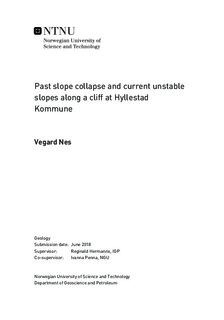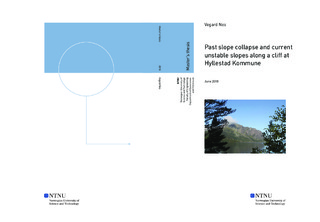| dc.description.abstract | With the aim of a complete national database of potential unstable slopes, the Geological Survey of Norway currently carries out systematic geological mapping of rock slopes organized in counties. As part of the survey of Sogn og Fjordane, a hazard and preliminary consequence assessment of a north-facing cliff in Hyllestad municipality has been completed within this thesis.
Two independent inventories were assembled, one on unstable rock slopes along the cliff face, the other on post-glacial rock slope failure deposits. In total 9 unstable slopes were detected, that present a total of 14 failure scenarios. In order to determine the hazard, the Norwegian hazard classification system was used. This comprises in mapping out the limiting structures, defining structural control, and a kinematic feasibility test of failures. In addition, at two sites displacement rates have been measured by dGNSS and extensometers, for the other, these were assessed based on morphological expression of deformation. Rockfall activity was assessed on a 3D photogrammetric model. The resulting hazard classification classified 12 of the scenarios to a medium hazard class, while 2 of the scenarios were classified with low hazard. The preliminary consequence assessment consisted of volume calculations based on delimiting structures and a run-out analysis considering the potential for initiating displacement waves. Of the detected scenarios, 3 have volumes defined that can fail as rock avalanches with excessive travel lengths. A run-out analysis using an empirical relation between volume and angle of reach indicate that the failure of all scenarios will reach the fjord.
The inventory of past events was assessed by bathymetric data from the fjord and digital terrain models on the shore. Deposits were interpreted, and volumes were estimated based on the SLBL-method. Frequencies have been analyzed based on the assumption of a constant frequency distribution since last deglaciation. This is supported by data from other fjords. Volume-Frequency distributions suggested a best fit of an inverse power-law model for volumes above a threshold of 0,020Mm3. Resulting frequency of rock slope failures with volumes ≥ 0,020Mm3 was estimated to 1 / 334 years. The frequency of rock avalanches (≥0,250Mm3) was estimated to 1 / 2879 years.
Based on the hazard classification of unstable slopes and frequencies of past events, the applicability of quantitative hazard probabilities has been discussed due to the need for quantitative limits for the Norwegian regulations on technical requirements for buildings. | |

